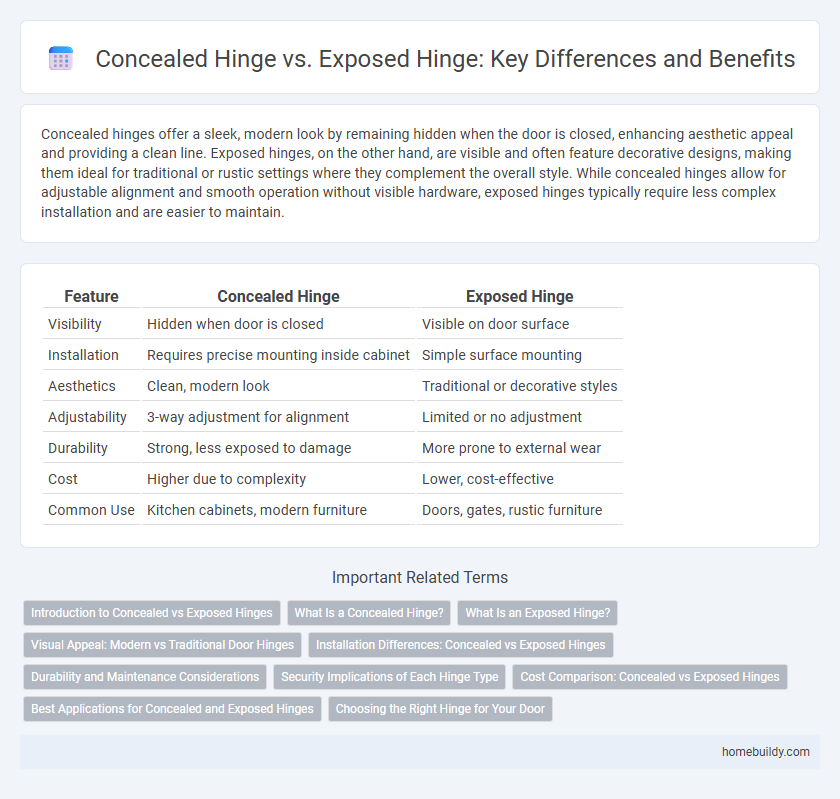Concealed hinges offer a sleek, modern look by remaining hidden when the door is closed, enhancing aesthetic appeal and providing a clean line. Exposed hinges, on the other hand, are visible and often feature decorative designs, making them ideal for traditional or rustic settings where they complement the overall style. While concealed hinges allow for adjustable alignment and smooth operation without visible hardware, exposed hinges typically require less complex installation and are easier to maintain.
Table of Comparison
| Feature | Concealed Hinge | Exposed Hinge |
|---|---|---|
| Visibility | Hidden when door is closed | Visible on door surface |
| Installation | Requires precise mounting inside cabinet | Simple surface mounting |
| Aesthetics | Clean, modern look | Traditional or decorative styles |
| Adjustability | 3-way adjustment for alignment | Limited or no adjustment |
| Durability | Strong, less exposed to damage | More prone to external wear |
| Cost | Higher due to complexity | Lower, cost-effective |
| Common Use | Kitchen cabinets, modern furniture | Doors, gates, rustic furniture |
Introduction to Concealed vs Exposed Hinges
Concealed hinges, also known as European hinges, are hidden within the cabinet frame for a sleek, modern appearance and allow for adjustable alignment. Exposed hinges are mounted on the outside of the door and frame, offering a traditional look with easier installation and maintenance. Both hinge types vary in durability, aesthetic appeal, and application suitability depending on design preferences and functionality requirements.
What Is a Concealed Hinge?
A concealed hinge is a type of door hinge designed to be hidden from view when the door is closed, providing a clean and seamless appearance. These hinges are commonly used in modern cabinetry and furniture for their aesthetic appeal and adjustable functionality. Concealed hinges offer better protection against tampering and allow for precise alignment compared to traditional exposed hinges.
What Is an Exposed Hinge?
An exposed hinge is a type of door hinge that remains visible when the door is closed, typically consisting of two plates connected by a pin mounted on the door and frame surfaces. These hinges are commonly made from durable materials such as brass, stainless steel, or iron, and are often used for their aesthetic appeal or ease of installation. Unlike concealed hinges, exposed hinges can be adjusted or replaced without removing the door, making them a practical choice for heavy or frequently used doors.
Visual Appeal: Modern vs Traditional Door Hinges
Concealed hinges offer a sleek, modern visual appeal by remaining hidden from view, creating clean lines and a minimalist aesthetic ideal for contemporary interiors. Exposed hinges, often crafted with decorative finishes, enhance traditional door styles by adding ornamental detail and craftsmanship that complement classic or rustic design themes. Choosing between concealed and exposed hinges significantly impacts the door's overall look, influencing whether the space feels modern and streamlined or warm and historically inspired.
Installation Differences: Concealed vs Exposed Hinges
Concealed hinges require precise mortising into the door and frame, demanding accurate measurements and specialized tools for flush installation, while exposed hinges mount directly onto the surface with screws, offering simpler and faster installation. Concealed hinges provide a cleaner look by hiding the hardware inside the door, making them ideal for modern cabinetry, whereas exposed hinges are visible and often used for traditional or decorative designs. The installation complexity and aesthetic outcome significantly influence hinge selection based on project requirements and skill level.
Durability and Maintenance Considerations
Concealed hinges offer superior durability due to protection from environmental factors that reduce wear and corrosion, unlike exposed hinges which are more vulnerable to damage and rust. Maintenance of concealed hinges is generally lower as they are shielded from dust and debris, allowing smoother operation over time. Exposed hinges require regular cleaning and lubrication to prevent squeaking and corrosion, increasing upkeep efforts.
Security Implications of Each Hinge Type
Concealed hinges offer enhanced security by remaining hidden from view, reducing the risk of tampering or forced entry compared to exposed hinges. Exposed hinges, while easier to install and adjust, present a vulnerability as their pins and mechanical components can be accessed and removed by intruders. Choosing concealed hinges significantly improves door security in residential and commercial settings by preventing unauthorized hinge manipulation.
Cost Comparison: Concealed vs Exposed Hinges
Concealed hinges generally incur higher costs due to intricate designs and installation requirements, often priced between $10 and $50 per hinge. Exposed hinges offer a more budget-friendly option, typically ranging from $3 to $15, making them ideal for cost-sensitive projects. Installation of concealed hinges frequently demands professional expertise, increasing labor expenses, whereas exposed hinges are easier to install, reducing overall costs.
Best Applications for Concealed and Exposed Hinges
Concealed hinges are ideal for modern cabinetry and furniture where a clean, seamless appearance is desired, such as in kitchens and office installations with flush surfaces. Exposed hinges are best suited for traditional wooden doors, vintage furniture, and exterior applications where durability and easy adjustment are important. Choosing concealed hinges enhances aesthetics and security, while exposed hinges offer simplicity and robust performance in heavy-use environments.
Choosing the Right Hinge for Your Door
Choosing the right door hinge involves considering both aesthetic and functional factors, with concealed hinges offering a sleek, modern look by remaining hidden when the door is closed, ideal for contemporary interiors. Exposed hinges, visible on the door's exterior, provide a traditional appearance and are typically easier to install and maintain, making them suitable for classic or rustic designs. Assessing door weight, usage frequency, and style preferences will help determine whether concealed or exposed hinges best fit your specific door requirements.
concealed hinge vs exposed hinge Infographic

 homebuildy.com
homebuildy.com